https://www.youtube.com/watch?v=u9pFG4yOp_Q
Three types of TSUKEMONO (Japanese pickles) Vegan 〜漬け物〜 _ easy Japanese side dish recipe
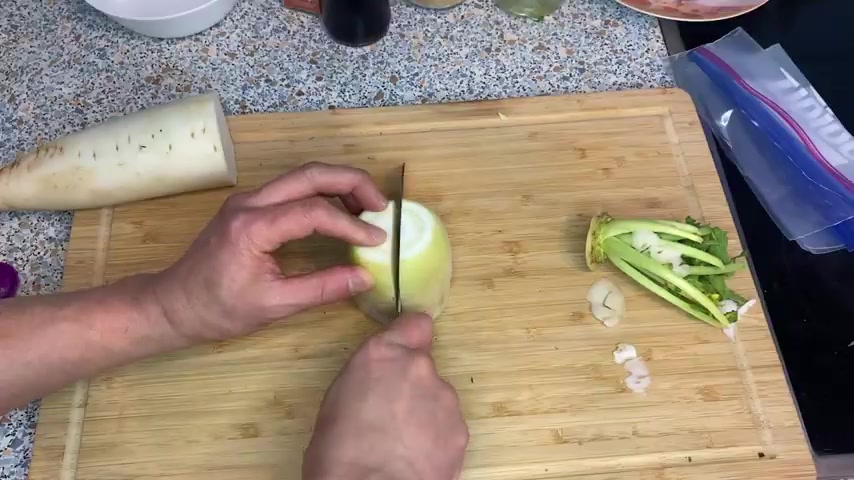
Welcome to Taha's kitchen today .
I'm going to show you how to make three types of Japanese pickles .
So in Japanese cuisine , there are quite a number of different kind of pickles .
If you go to a restaurant in Japan , and then you order like a set menu , you would almost always have a type of pickle .
It's sometimes called , which means a resting of chopsticks and it just kind of has that refreshing element for the whole meal because uh you have the main dish that can be heavy and then after , while your mouth may want to a little something different .
So a lot of the Japanese pickles have this kind of refreshing element to it today .
I'm gonna show you three different variations that are very easy to make .
Each process takes no more than like 5 to 10 minutes .
Well , except for the soaking part , that's gonna take a while , you don't have to do anything .
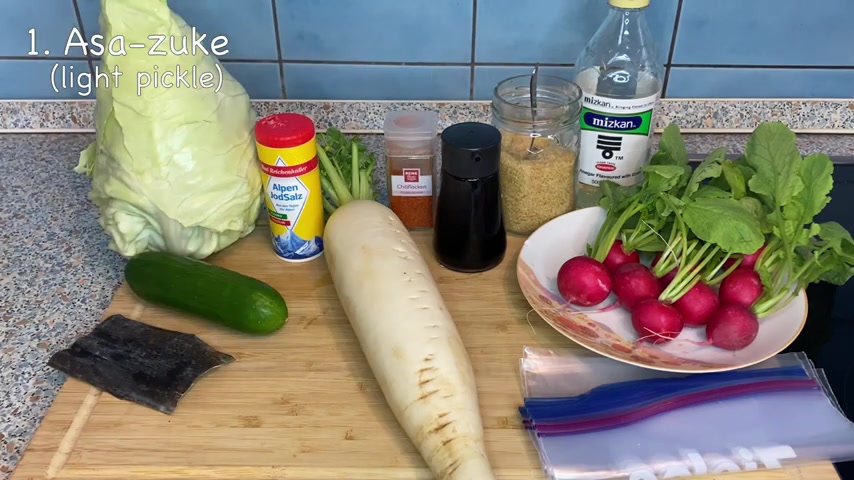
So the actual process that you're gonna do is gonna take no more than 5 to 10 minutes .
So I hope you enjoy it and hopefully try it yourself .
Then let's get started .
Here are the ingredients for three different kinds of Japanese pickles .
First , we're going to make a , or a light pickle with cabbage and cucumber .
And we're also going to use combo kelp for that .
And for the seasoning , we're just gonna use salt .
And secondly , we're going to make soy sauce pickle with white radish or dyco radish .
And for the seasoning , we're going to use soy sauce and sugar and a little bit of chili .
And then lastly , we're going to make sweet and sour pickle with regular radish .
And for this season , we're going to use sugar and also rice wine vinegar .
If you don't have rice wine vinegar , then you can just use regular white wine vinegar or apple vinegar .
And today we're going to be using a Ziploc for the pickles .
But if you don't have Ziploc or if you don't want to use ziploc , then you can use regular tapper ware or any container would do .
So let's cut up the ingredients .
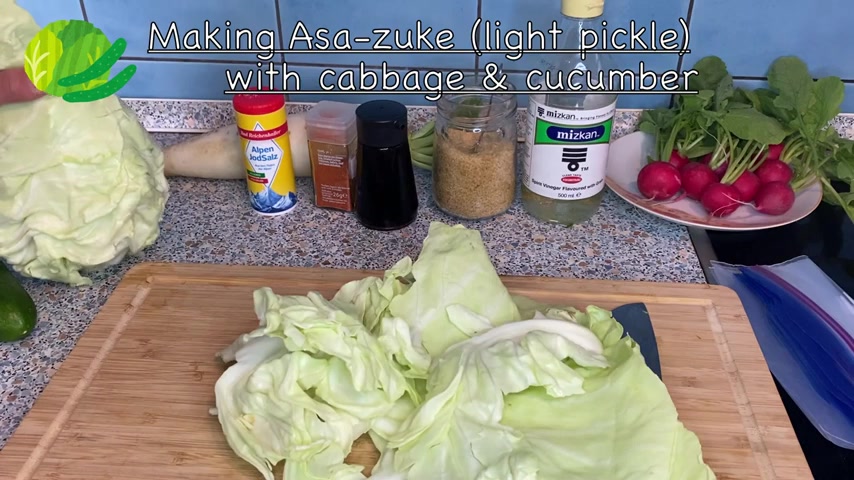
So for today , I'm just gonna use two leaves .
So I'm just gonna take this stem part , I'm gonna cut these stem part , extra thin so that they'll get pickled faster .
And then I'm just gonna cut these into by size pieces and then also the cucumber , take the top and the bottom off and then I'm just gonna cut these into thin slices and then I'm just gonna cut into small pieces .
So in a bigger zip lock , I'm gonna put in the all the vegetables and also the .
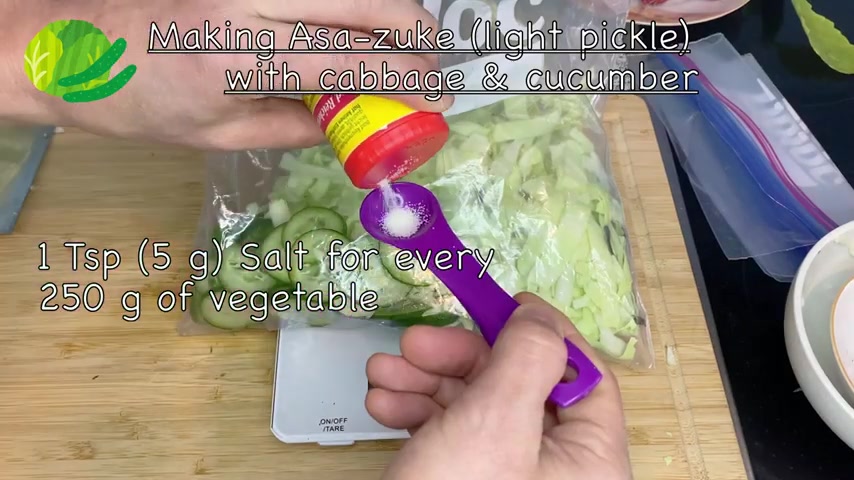
So in this , you wanna put about 2% of salt .
So if I measure this , this is about 280 g minus the ziploc , then I would say it's about 250 g .
And then for every 250 g of vegetable , you're gonna put about 5 g of salt .
That is about a teaspoon .
So then about a teaspoon , I'm gonna put this in here .
You wanna get a lot of air in and then lock it and then this is why I like using a zip lock because you can just mix it very easily and evenly and then get the air out .
And then what you wanna do is you wanna kind of push it together so that the vegetable will get damaged and then salt will sink in better .
Now , I'm gonna just let it sit for a couple hours to a day or so .
Next , we're going to make the or the soy sauce pickle .
So for this , I'm gonna use the top part because the bottom part , you wanna use it for cooking the top part .
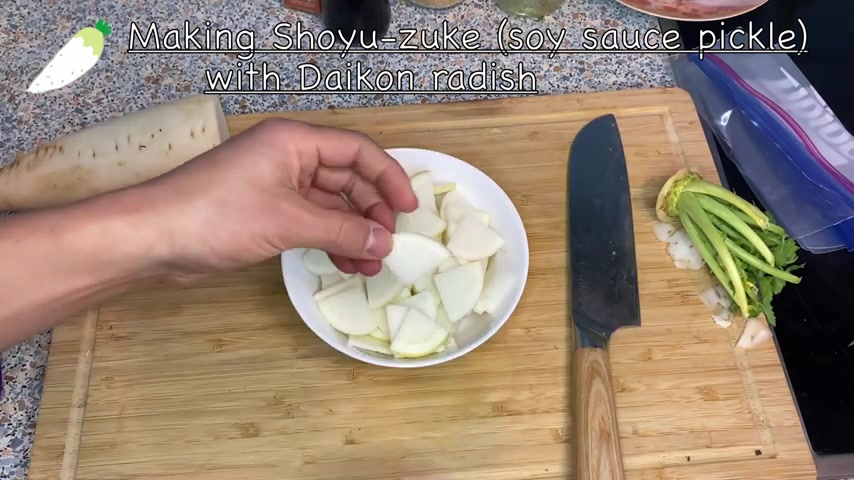
You wanna use it for raw and I'm gonna just take the top off and today I'm just gonna use a third or so , if there's a like damaged part , then you are just gonna take it out .
It's a little darker , it's gonna get that part off .
If you want to peel the white radish , of course , you can I don't really think it's necessary .
So I'm just gonna use it like that .
And then I'm gonna cut these into bite size pieces .
So this , you don't wanna cut it too thin .
It's about half a centimeter or so .
And by the way , this way of cutting is called or agile leaves cut because this kind of looks like a leaf , just a little trivia , just gonna put it in here in the zip block .
And then in this , I'm gonna put in two tablespoons of soy sauce and then one tablespoon of sugar .
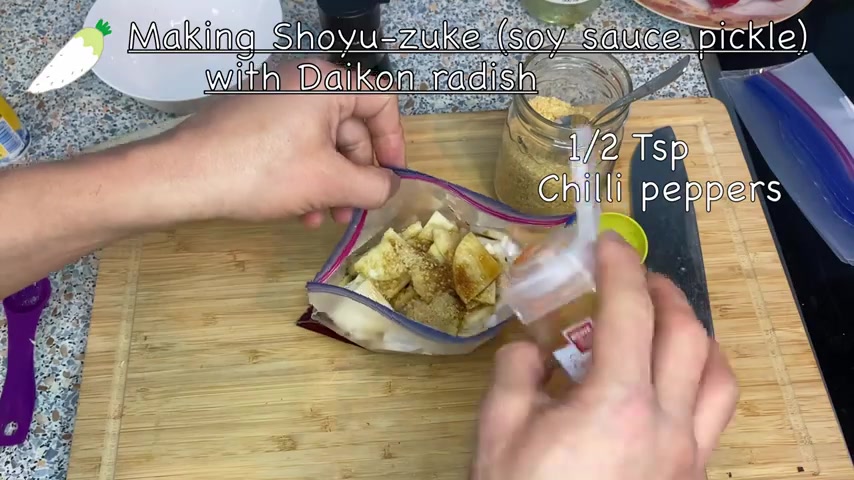
And then here if you wanna make it a little spicy , then you can put a lot of chili .
If you don't like it spicy , then you can just skip the chili how much you want like that much .
And then what you want to do is you wanna try to get as much air out as possible and then you wanna try to get the soy sauce all around .
After a couple of you notice that the dyco radish is going to give out the water and then this is gonna be much , much liquidity .
And then at that point , you want to squeeze the air much more .
And then for the , you want to let it sit for at least a day or so , then let's make the sweet and sour pickle with the radish for this recipe .
I'm not going to be using the beefs .
So I'm just gonna cut this off .
Here like this , but don't throw these away and you can use this for salad or you can try it .
Uh It's also very delicious .
I'm gonna take that off and then it's gonna come to pieces like this .
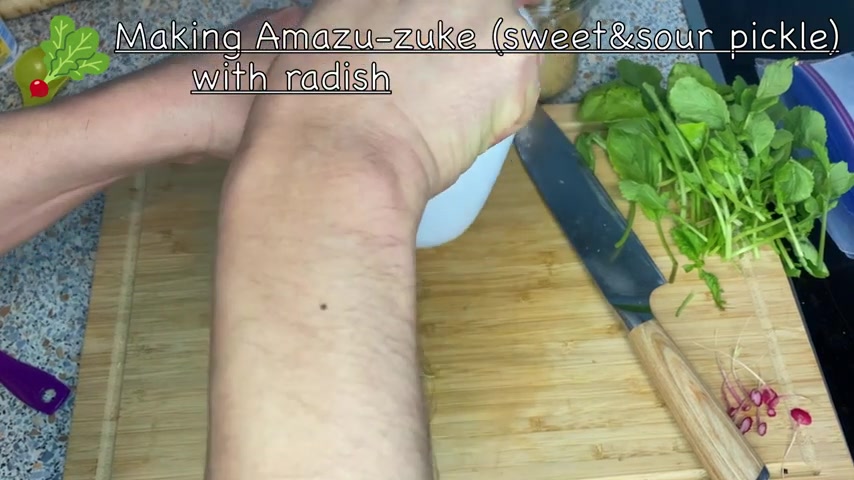
Then we're gonna put this in a zip lock for this recipe .
We're gonna put two tablespoons of sugar and then also a two tablespoon of rice , wine vinegar or any vinegar and half a teaspoon of salt .
And then again , also for this gonna mix it like this and then also for this as well , you're gonna try to get as much air as possible .
Yeah , then this is finished and don't worry too much about the sugar that's not dissolved yet .
It will dissolve in like the next hour or so .
And for this also , you want to let it sit at least overnight .
So here we have three different kinds of pickles .
And as you can see , the amount has decreased and it's gotten much softer after now , like 10 , 15 minutes .
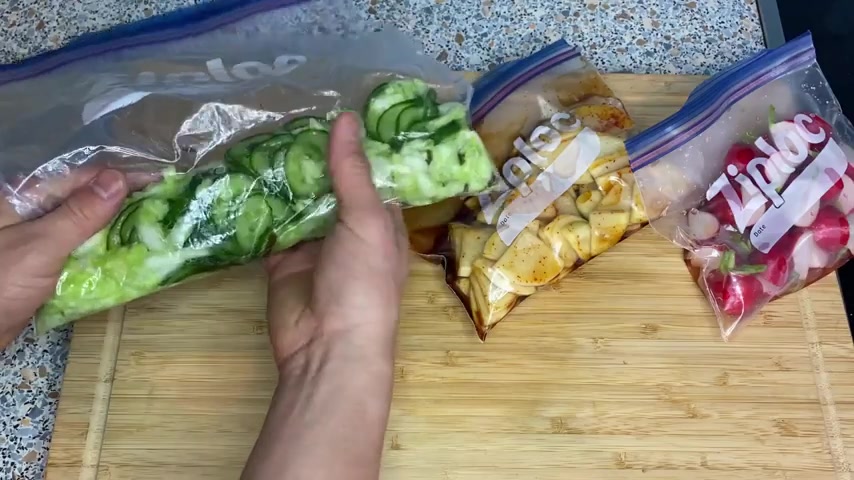
Then at this point , what you want to do is , you know , open up a little bit and then you wanna try to get as much air out as possible like some and in this way , it will have a similar effect as a vacuum .
That's all the surface will be touching the sauce .
And here the Dyco rash has already gotten softened .
So what you want to do is you want to kind of open it a little bit and then try to the air out as much as possible without leaking .
And then you have very little air in here .
And that's why I like to use the Ziploc .
So this will get pickled very evenly and this also , this has gotten softened .
So I'm just gonna get as much air out as possible .
Like this one , Ben , let's go to the next thing .
So a day has passed and the pickles are ready .
So as you can see , they're all good pickles , they're all kind of soaking up the juice and the radish , they kind of give out the color of the skin .
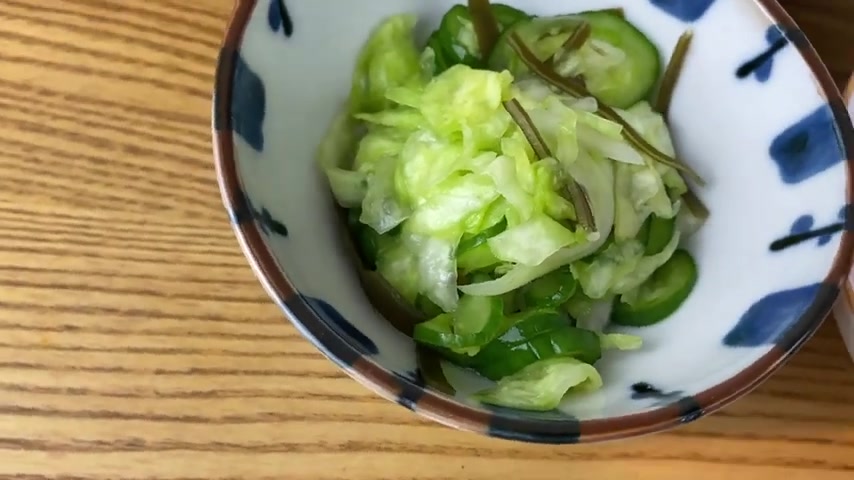
That's why I like making pickles with these .
Then let's serve .
So this is finished .
Let's eat .
Ok , let's eat .
So this is a bit strange to have just only pickles and rice .
But oh well , so let's start with the , this is the light pickle with cabbage and cucumber .
Egg .
Hm .
The sauce is perfect .
Hm .
Mm .
So the salt is really bringing out the sweetness of the vegetable and there's also this very fine aroma of the combo .
Very delicious .
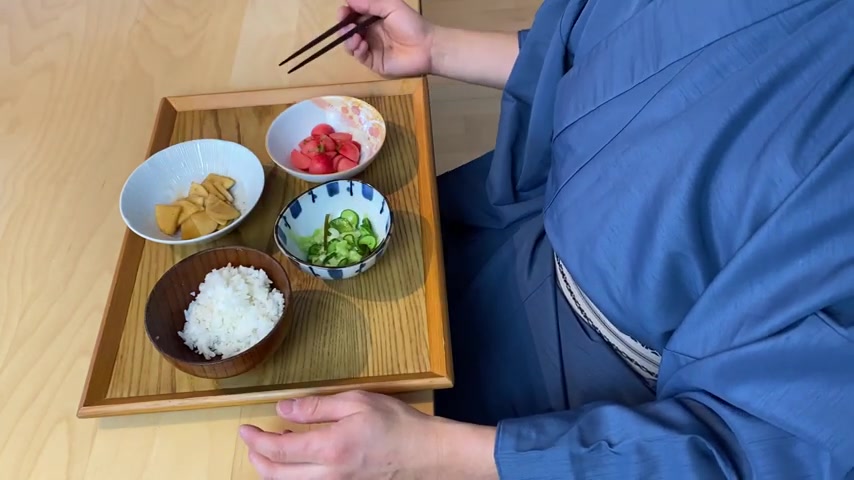
Let's have the soy sauce pickle .
Hey .
Hm .
The consciousness of the white radish is really delicious .
So this combination of soy sauce and sugar .
It is the same as the teriyaki sauce and this just masters the white radish perfectly .
And there's that kick from the chili .
It's really great .
Mm hm .
And lastly the radish pickle So I think it's really cute to have this kind of pink color .
Hm .
Hm .
So the sweet and sour pickle is distinctly different from the other two .
The other two are solely based , but it's like the sweetness and the sourness .
This is very refreshing .
Hm .
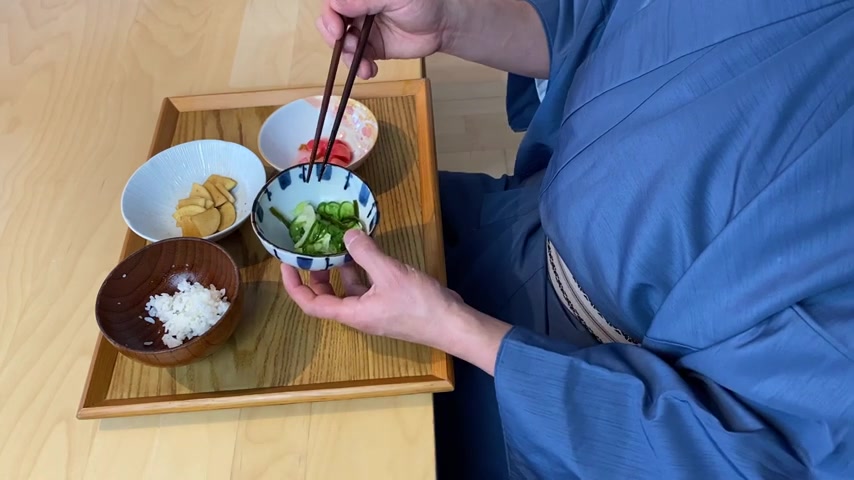
Oh , if you haven't noticed this sweet and sour is pretty much the same combination as the sushi rice , of course , it is going to match rice .
So these pickles or any pickle in Japan are meant to match rice .
And for that reason , these pickles are a little bit too salty to be just eaten as it is .
Hm .
That was delicious .
Go sell some stuff today .
I just show you with three vegetables or actually four vegetables , but you can of course use other vegetables like carrots , celery , what else ?
Eggplant turn up or like napa , cabbage , tomato or avocado .
They're also good as well .

And then some vegetable you might want to precook before you pickle them like asparagus , broccoli , cauliflower or like a zucchini .
So uh just be creative with it and you never know what you'll find and it might be your new favorite .
So I hope this video is important for you .
I hope it give you some new ideas and if you like what you saw , please hit that like button .
Otherwise I look forward to see you in the next video .
Bye .
Are you looking for a way to reach a wider audience and get more views on your videos?
Our innovative video to text transcribing service can help you do just that.
We provide accurate transcriptions of your videos along with visual content that will help you attract new viewers and keep them engaged. Plus, our data analytics and ad campaign tools can help you monetize your content and maximize your revenue.
Let's partner up and take your video content to the next level!
Contact us today to learn more.